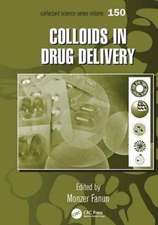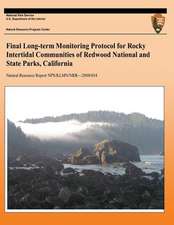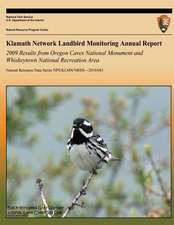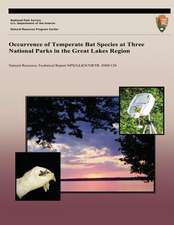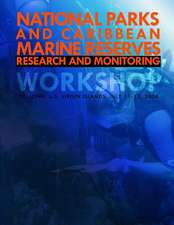The Role of Colloidal Systems in Environmental Protection
Editat de Monzer Fanunen Limba Engleză Hardback – 27 feb 2014
- Provides the applied technological features of colloids in environmental protection
- Gives insight into the use of bio-solid colloids as contaminant carriers
- Covers the natural occurrence of biosurfactants in the environment and their applications
- Provides information on the use of nanoparticles for environmental applications
- Chapters written by recognized and respected experts in the field from all over the world
Preț: 832.15 lei
Preț vechi: 1153.47 lei
-28% Nou
Puncte Express: 1248
Preț estimativ în valută:
159.28€ • 173.07$ • 133.88£
159.28€ • 173.07$ • 133.88£
Carte tipărită la comandă
Livrare economică 14-28 aprilie
Preluare comenzi: 021 569.72.76
Specificații
ISBN-13: 9780444632838
ISBN-10: 0444632832
Pagini: 720
Dimensiuni: 191 x 235 x 38 mm
Greutate: 1.47 kg
Editura: ELSEVIER SCIENCE
ISBN-10: 0444632832
Pagini: 720
Dimensiuni: 191 x 235 x 38 mm
Greutate: 1.47 kg
Editura: ELSEVIER SCIENCE
Public țintă
Chemical engineers; post-graduate students and scientists in colloid, surface, physical and polymer chemistry, and in environmental and materials science working in a wide variety of industriesCuprins
1. Biosolid Colloids as Environmental Contaminant Carriers (J.O. Miller, A.D. Karathanasis)
2. Influence of Natural Organic Matter on Contaminant Removal by Permeable Reactive Barrier (Daniel C.W. Tsang)
3. Role of Microbial Surface-Active Compounds in Environmental Protection (Danka Galabova, Anna Sotirova, Elena Karpenko, Oleksandr Karpenko)
4. Review on the Utilization of Low-cost Substrates to Obtain Metabolites for Protection of the Environment (Ana B. Moldes)
5. Use of Cloud Point Extraction with Ethoxylated Surfactants for Organic Pollution Removal (B. Haddou, J.P. Canselier, C. Gourdon)
6. Adsorption of Synthetic Surfactants from Aqueous Solutions on Natural Adsorbents (Alisa Sineva)
7. Co-Contaminant-Aided Removal of Organics from Produced Water Using Micellar-Enhanced Ultrafiltration (Ali Deriszadeh, Maen M. Husein, Thomas G. Harding)
8. Heavy Metals Uptake from Aqueous Effluents by Novel Adsorbent Derived from Tannin Extracts: Role of Tannin Source (Sanchez-Martin, J. Beltran-Heredia, V. Encinas-Sanchez)
9. The Contribution of the Coagulation Process in Controlling Microbial Risk and Disinfection By-products Formation in Drinking Water (Luigi Rizzo)
10. Coagulation–Flocculation Method for the Treatment of Pulp and Paper Mill Wastewater (Tjoon Tow Teng, Sook San Wong, Ling Wei Low)
11. Arsenic Removal from Water by the Coagulation Process (Shaoxian Song, Marisol Gallegos-Garcia)
12. Optimization and Modeling of Decolorization and COD Reduction of Reactive Dye Solutions by Coagulation Processes with SIWW’s Coagulant (Abdelkader Anouzla, Younes Abrouki, Salah Souabi, Mohamed Safi, Hicham Rhbal)
13. Modified and Nonmodified TiO2 Nanoparticles for Environmental Applications (Vassiliki Belessi, Dimitris Petridis)
14. Groundwater Purification and Soil Remediation Using Carbon Colloids (Rashid A. Khaydarov, Renat R. Khaydarov, O. Gapurova)
15. Quebracho colorado: A New Source for Water Coagulant—Performance on Dye Removal (J. Sanchez-Martin, J. Beltran-Heredia, B. Coco-Rivero)
16. Biosorption of Uranium and Thorium by Biopolymers (C. Gok, S. Aytas)
17. Colloid-Mediated Transport and the Fate of Contaminants in Soils (Maria Gavrilescu)
18. Micellar Solutions to Recover Diesel in Sand (Leticia A. Bernardez, Luiz R.P. de Andrade Lima)
19. Recent Advances on the Use of Surfactant Systems as Inhibitors of Corrosion on Metallic Surfaces (Alcides de Oliveira Wanderley Neto, Tereza Neuma de Castro Dantas, Afonso Avelino Dantas Neto, Alexandre Gurgel)
20. The Role of Corrosion Inhibitors in Protecting Metallic Structures against Corrosion in Harsh Environments (El-Sayed M. Sherif)
21. Petroleum Products Transporting Pipeline Corrosion—A Review (N. Muthukumar)
22. Aerogels in the Environment Protection (D.R. Chen, X.H. Chang, X.L. Jiao)
23. Effective Utilization of Solid Waste from Leather Industry (N. Nishad Fathima, J. Raghava Rao, Balachandran Unni Nair)
24. Applications of Porous Media Combustion Technology (M. Abdul Mujeebu, A.A. Mohamad, M.Z. Abdullah)
25. Colloids in the Environmental Protection—Current and Future Trends (Qaisar Mahmood (TI), Ather Farooq Khan, Afsar Khan)
2. Influence of Natural Organic Matter on Contaminant Removal by Permeable Reactive Barrier (Daniel C.W. Tsang)
3. Role of Microbial Surface-Active Compounds in Environmental Protection (Danka Galabova, Anna Sotirova, Elena Karpenko, Oleksandr Karpenko)
4. Review on the Utilization of Low-cost Substrates to Obtain Metabolites for Protection of the Environment (Ana B. Moldes)
5. Use of Cloud Point Extraction with Ethoxylated Surfactants for Organic Pollution Removal (B. Haddou, J.P. Canselier, C. Gourdon)
6. Adsorption of Synthetic Surfactants from Aqueous Solutions on Natural Adsorbents (Alisa Sineva)
7. Co-Contaminant-Aided Removal of Organics from Produced Water Using Micellar-Enhanced Ultrafiltration (Ali Deriszadeh, Maen M. Husein, Thomas G. Harding)
8. Heavy Metals Uptake from Aqueous Effluents by Novel Adsorbent Derived from Tannin Extracts: Role of Tannin Source (Sanchez-Martin, J. Beltran-Heredia, V. Encinas-Sanchez)
9. The Contribution of the Coagulation Process in Controlling Microbial Risk and Disinfection By-products Formation in Drinking Water (Luigi Rizzo)
10. Coagulation–Flocculation Method for the Treatment of Pulp and Paper Mill Wastewater (Tjoon Tow Teng, Sook San Wong, Ling Wei Low)
11. Arsenic Removal from Water by the Coagulation Process (Shaoxian Song, Marisol Gallegos-Garcia)
12. Optimization and Modeling of Decolorization and COD Reduction of Reactive Dye Solutions by Coagulation Processes with SIWW’s Coagulant (Abdelkader Anouzla, Younes Abrouki, Salah Souabi, Mohamed Safi, Hicham Rhbal)
13. Modified and Nonmodified TiO2 Nanoparticles for Environmental Applications (Vassiliki Belessi, Dimitris Petridis)
14. Groundwater Purification and Soil Remediation Using Carbon Colloids (Rashid A. Khaydarov, Renat R. Khaydarov, O. Gapurova)
15. Quebracho colorado: A New Source for Water Coagulant—Performance on Dye Removal (J. Sanchez-Martin, J. Beltran-Heredia, B. Coco-Rivero)
16. Biosorption of Uranium and Thorium by Biopolymers (C. Gok, S. Aytas)
17. Colloid-Mediated Transport and the Fate of Contaminants in Soils (Maria Gavrilescu)
18. Micellar Solutions to Recover Diesel in Sand (Leticia A. Bernardez, Luiz R.P. de Andrade Lima)
19. Recent Advances on the Use of Surfactant Systems as Inhibitors of Corrosion on Metallic Surfaces (Alcides de Oliveira Wanderley Neto, Tereza Neuma de Castro Dantas, Afonso Avelino Dantas Neto, Alexandre Gurgel)
20. The Role of Corrosion Inhibitors in Protecting Metallic Structures against Corrosion in Harsh Environments (El-Sayed M. Sherif)
21. Petroleum Products Transporting Pipeline Corrosion—A Review (N. Muthukumar)
22. Aerogels in the Environment Protection (D.R. Chen, X.H. Chang, X.L. Jiao)
23. Effective Utilization of Solid Waste from Leather Industry (N. Nishad Fathima, J. Raghava Rao, Balachandran Unni Nair)
24. Applications of Porous Media Combustion Technology (M. Abdul Mujeebu, A.A. Mohamad, M.Z. Abdullah)
25. Colloids in the Environmental Protection—Current and Future Trends (Qaisar Mahmood (TI), Ather Farooq Khan, Afsar Khan)


